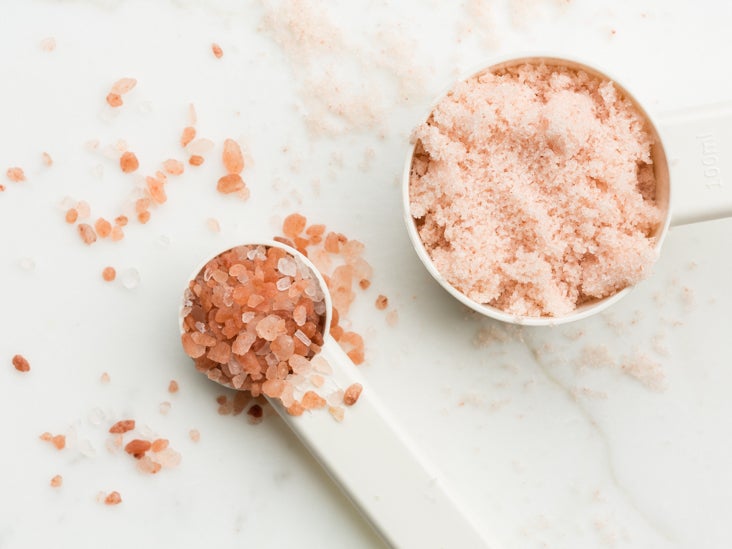Just as the culinary world has witnessed a staggering variety of ingredients, the realm of salts is no different. But when it comes to comparing Pink Himalayan Salt and Regular Salt, which one stands on the higher ground? Let’s embark on a journey to explore the subtleties of these salt varieties and delve into the ocean of mineral diversity.
What Is Salt?
Salt, a compound made up primarily of sodium chloride (NaCl), is an essential nutrient necessary for human survival. It regulates the fluid balance in our bodies and plays a crucial role in nerve function. The most common type of salt we encounter is table salt, which is obtained from salt mines or by evaporating sea water. This regular salt is typically heavily refined, with its impurities and trace minerals removed. Also, it’s often fortified with iodine to help prevent iodine deficiency.
Even though salt is a fundamental part of our diet, too much of it can cause high blood pressure and other health issues. This has led people to explore different types of salts, including Pink Himalayan salt, that might offer health benefits or at least add variety to their diet. Interestingly, the choice of salt can even enhance your cooking experience, just like the use of Organic Sesame Seeds can enrich your dishes with their nutty flavor and health benefits.
What Is Pink Himalayan Salt?
Pink Himalayan salt is a type of rock salt that hails from the Punjab region of Pakistan, near the Himalayas. Its pinkish hue is a result of the presence of several trace minerals, including iron. This salt is hand-extracted and minimally processed to yield an unrefined product that’s free of additives and much closer to its natural state than table salt.
Like other salts, Pink Himalayan salt consists mostly of sodium chloride. However, the natural harvesting process allows it to retain trace minerals, giving it a slightly different flavor and making it a favorite among gourmet cooks. It’s akin to the difference between regular sesame seeds and the robust flavor of Black Sesame Seeds powder from Arm Commodities, a favorite among health-conscious consumers.
How Is Pink Himalayan Salt Used?
Pink Himalayan salt is incredibly versatile and is used in various culinary and non-culinary applications. In the kitchen, it’s used just like you would use regular salt. It can be used to season meals, and due to its coarse texture, it provides a delightful crunch when used as a finishing salt. In terms of culinary uses, it’s as versatile as the Best Ways To Use Sesame Seeds.
Apart from its culinary uses, Pink Himalayan salt is often used in salt lamps due to its alleged air purifying properties. It’s also used in bathing salts, as it’s believed to have skin-benefiting minerals. Similar to how Sesame seeds benefits for men and women have been recognized for overall health, Pink Himalayan salt is gaining attention in the wellness community.
You Can Eat It or Cook With It
One can certainly consume Pink Himalayan salt or use it for cooking. However, because it is typically more expensive than regular salt, many people reserve it for specific uses that will highlight its unique characteristics. For instance, sprinkling it over a steak before grilling will not only season the meat but will also create a crisp, flavorful crust, much like the delightful crunch one might experience when adding Roasted Sesame Seeds to a salad.
Considerations for Cooking
While cooking with Pink Himalayan salt, remember that its larger crystals mean it has less salt per teaspoon compared to regular table salt. It might be necessary to adjust your measurements if you are substituting it for regular salt in a recipe. It’s similar to understanding the difference between Hulled Vs Unhulled Sesame Seeds and adjusting the usage accordingly.
Non-Dietary Uses
Beyond the culinary world, Pink Himalayan salt finds its place in several non-dietary uses. Its distinctive color and mineral composition make it a popular choice for decorative salt lamps, claimed to purify the air, although there’s limited scientific evidence supporting this. You’ll also find it in bath salts and spa treatments, asserting benefits similar to How Black Sesame Seeds Benefit Hair.
Pink Himalayan Salt Contains More Minerals
Indeed, Pink Himalayan salt does contain more trace minerals than regular salt. However, these are present in such small quantities that they are unlikely to bring substantial health benefits. The primary advantage of Pink Himalayan salt lies in its pure, unprocessed nature, much like the appeal of Benefits Of Black Sesame Seeds and White Sesame Seeds.
Are the Health Claims True?
There’s no denying that Pink Himalayan salt has a richer mineral content compared to regular salt. However, these minerals are present in minuscule amounts. Therefore, one cannot expect to derive significant health benefits from these trace minerals alone. It’s similar to appreciating the Sesame Seeds Benefits, but understanding that a balanced diet and lifestyle are the keys to health.
To conclude, the choice between Pink Himalayan salt and regular salt comes down to personal preference. Whether it’s for the subtle flavor differences, the attractive pink color, or the minimal processing, Pink Himalayan salt is indeed a unique alternative to regular salt. However, just like deciding on how to toast sesame seeds to bring out the best flavor, your choice of salt should align with your culinary preferences and health goals.

